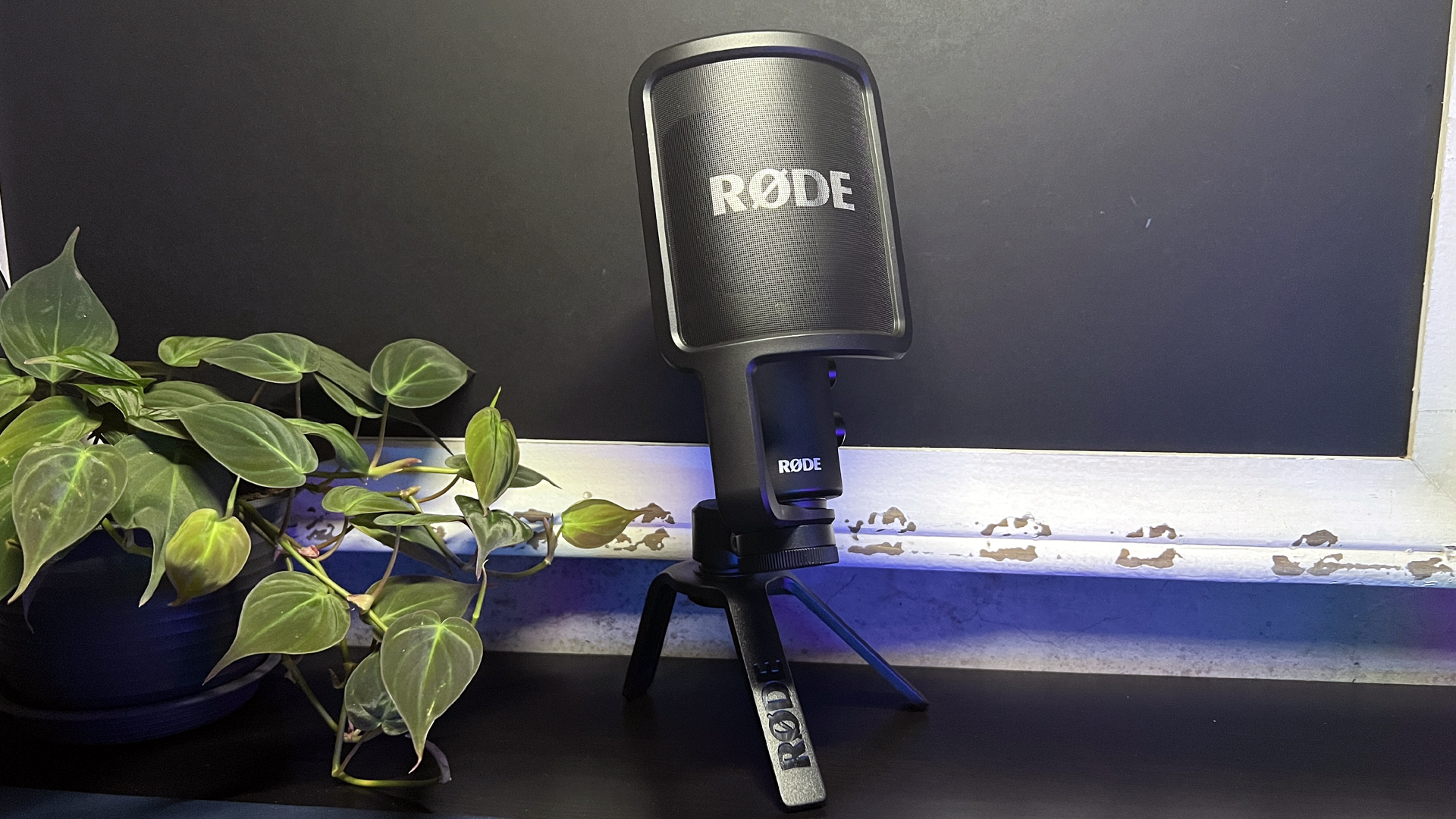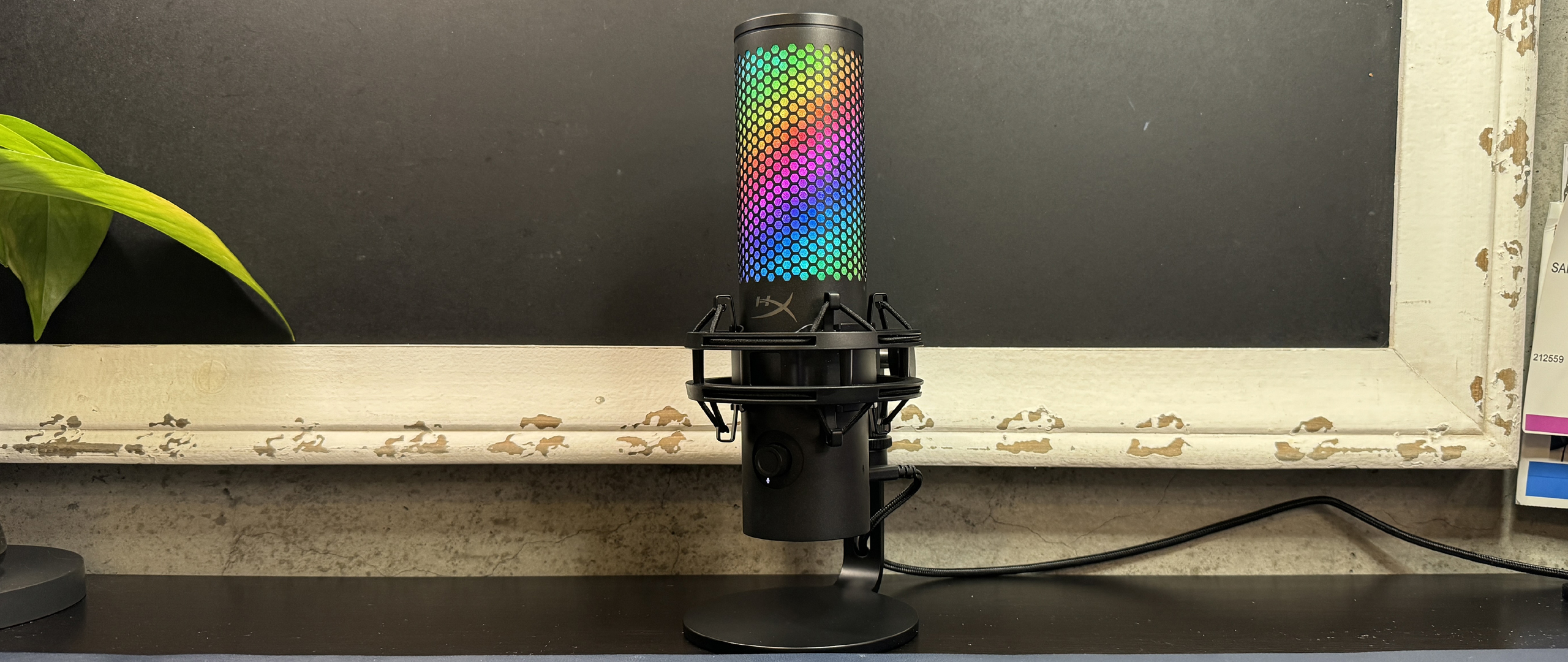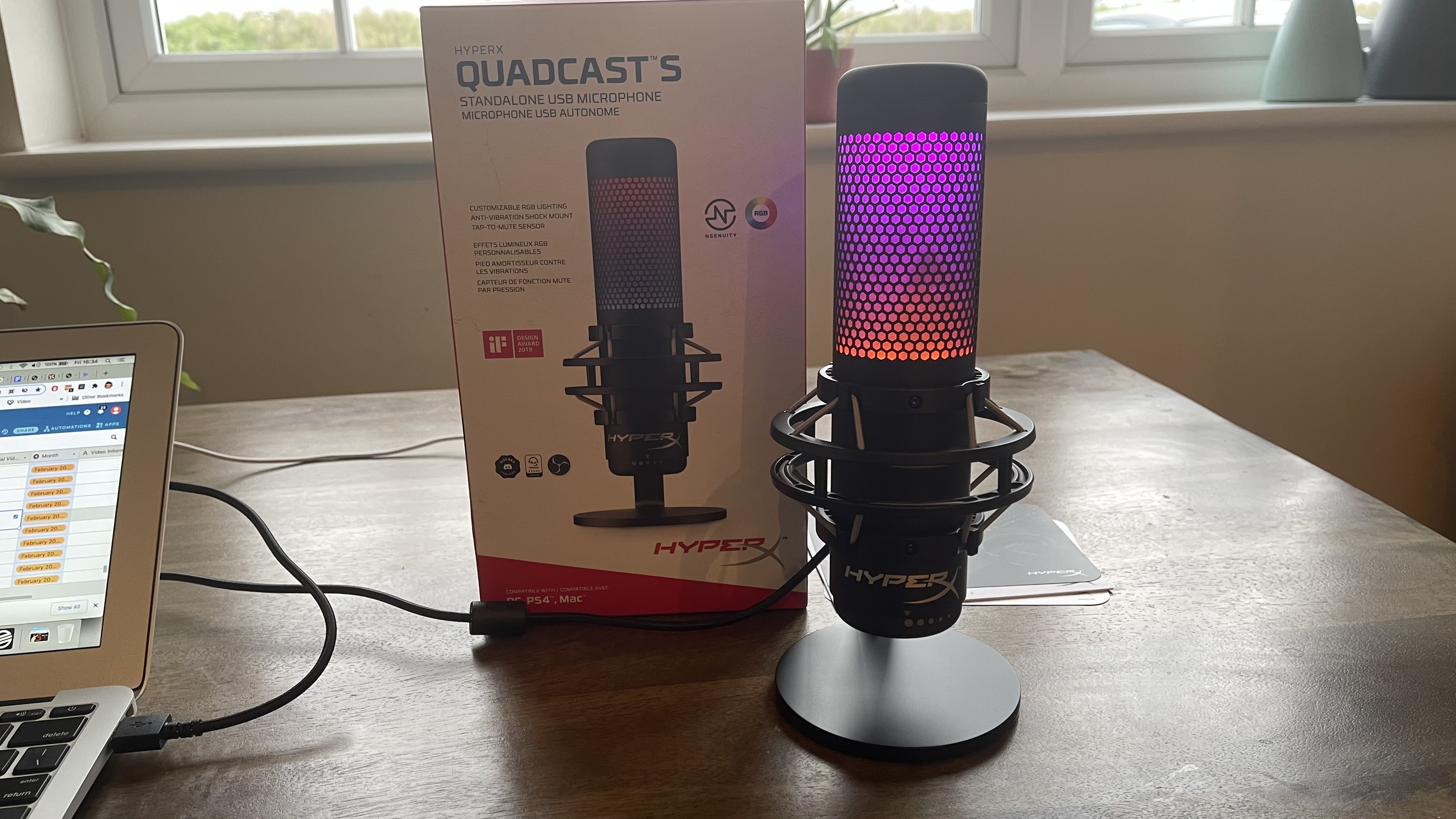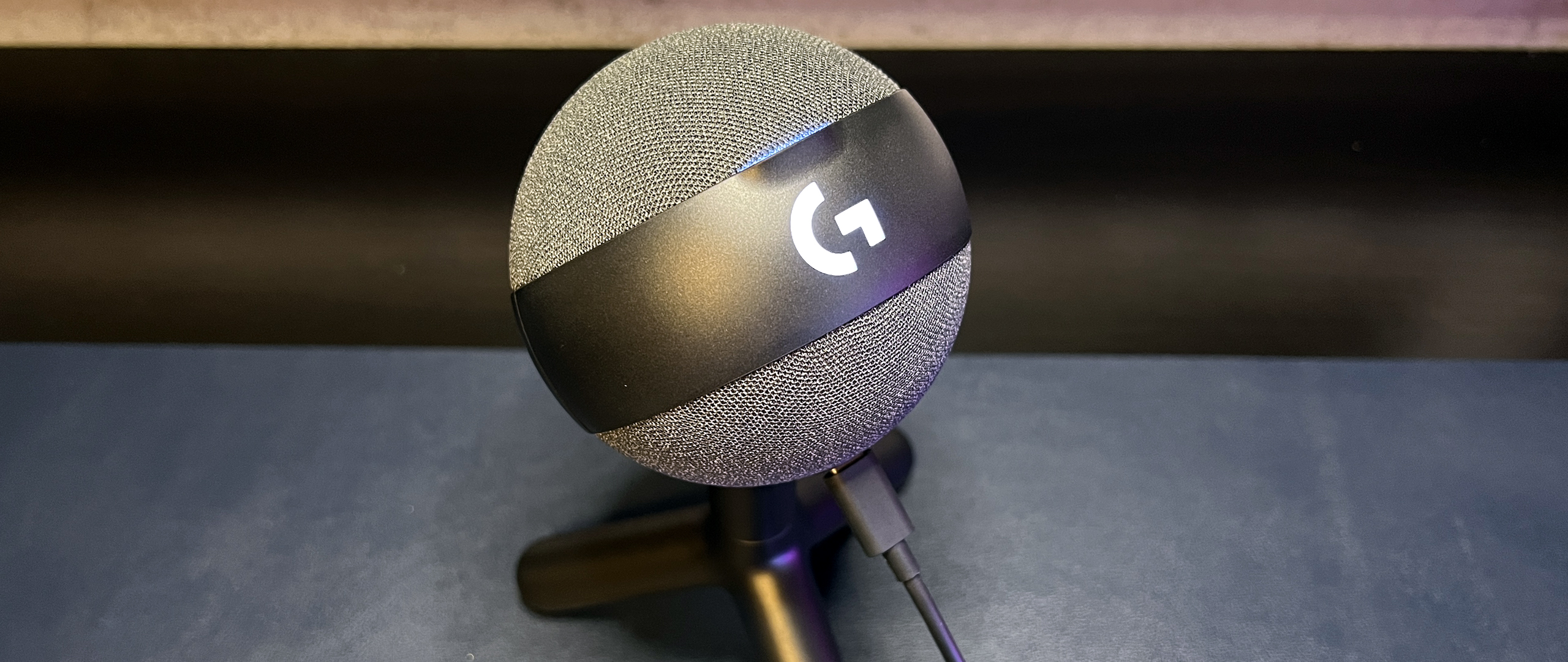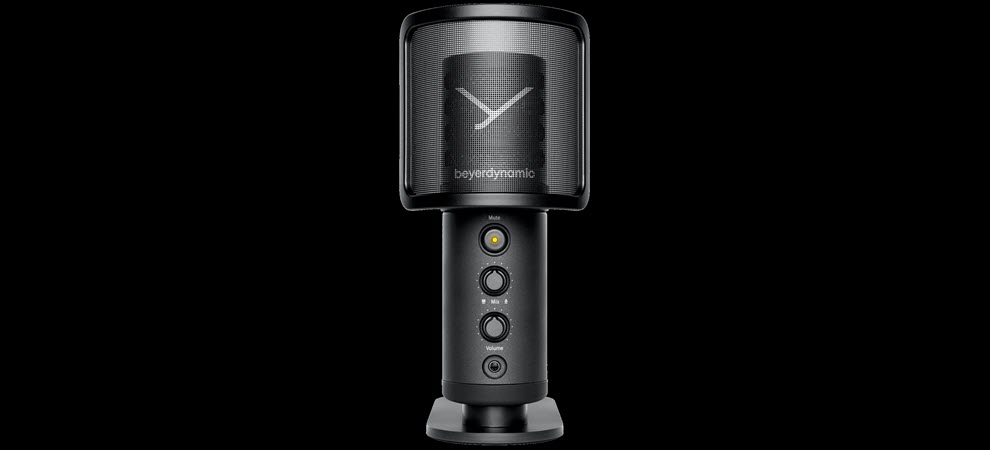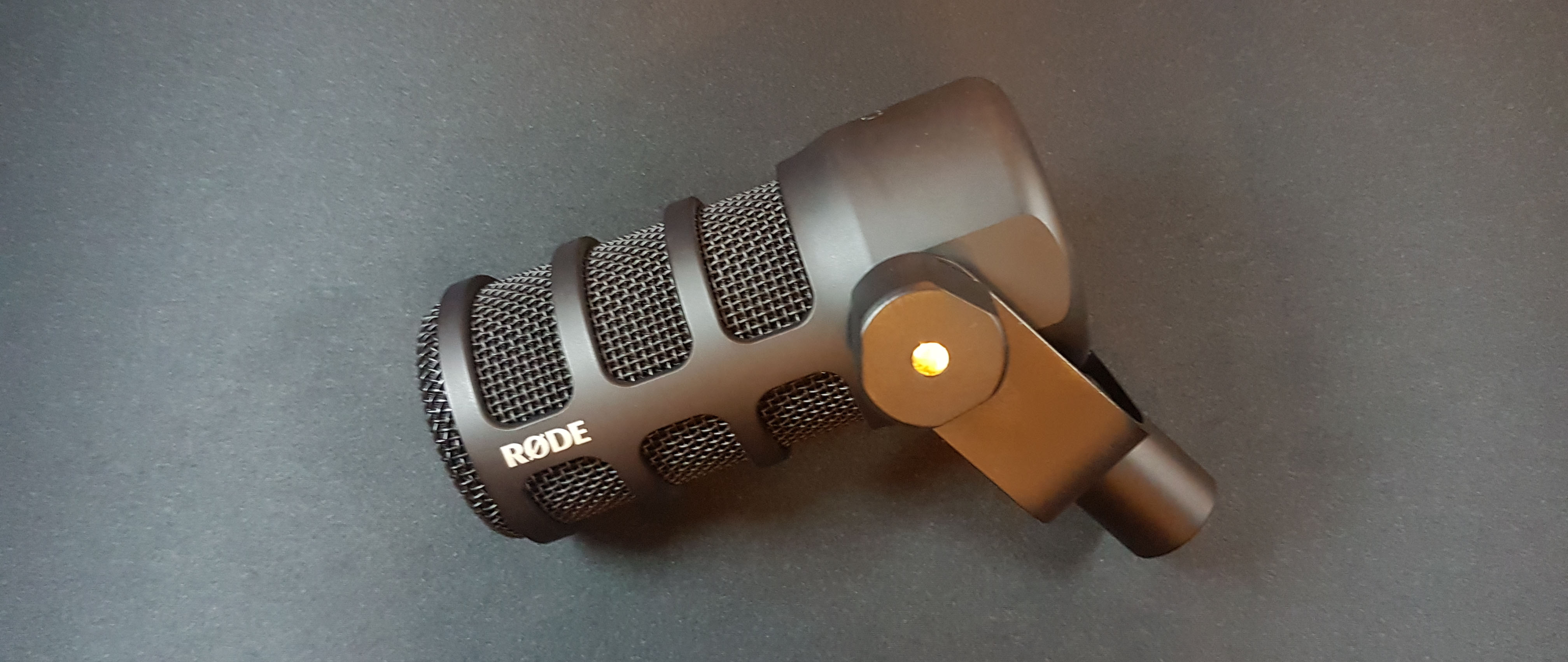Best Gaming Microphones 2025
The best gaming microphones for strategizing, streaming... and singing.

The best gaming headsets have some pretty impressive built-in mics these days, but they're built to multi-task — they won't deliver that professional-grade clarity you hear on the radio. A standalone mic will not only make your voice sound better and clearer to your teammates, coworkers, and viewers, it can also be used for other things (such as podcasting or recording music).
You don't need to go full-on audio nerd and get an XLR mic (though you can) to upgrade your voice comms — a spare USB port or mic jack is usually all you need for an interface. If you've already upgraded to one of the best gaming keyboards and one of the best gaming mice, it's time to pick up a standalone gaming mic.
The Quick List
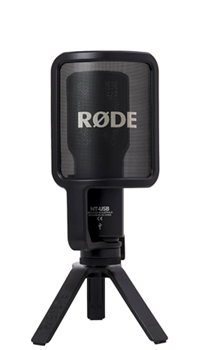
Best Gaming Microphone for Most
A sturdy, professional mic with upgraded circuitry that produces full, warm, broadcast-quality vocals in a plug-and-play package.
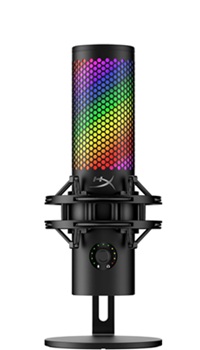
Best Gaming Microphone for Streaming
The newest iteration of an iconic gaming mic with great sound, four polar patterns, and highly customizable aRGB lighting.

Best Gaming Microphone for Talking
A long-standing favorite mic with bright, colorful RGB, four polar patterns, and the best tap-to-mute implementation around.
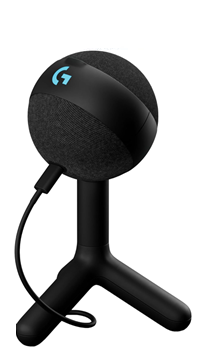
Best Budget Gaming Microphone
The new, darker, $60 snowball that sounds awesome out of the box.
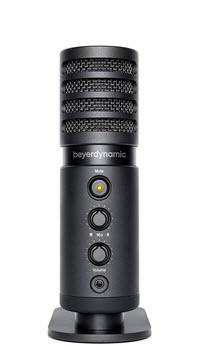
Best Gaming Microphone for Music Recording
A hi-res mic with 96 kHz/24-bit recording, on-mic controls, and a sturdy pop filter.
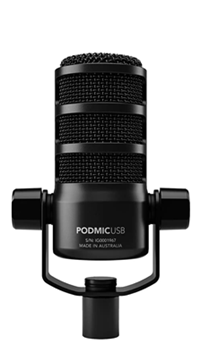
Best Gaming Microphone for Podcasting
It's in the name: the PodMic USB is an end-address mic with both USB-C and traditional XLR connectivity, which means it's a great option for both gaming and podcasts.
The Best Gaming Microphones You Can Buy Today
Why you can trust Tom's Hardware
Best Gaming Microphone for Most
Specifications
Reasons to buy
Reasons to avoid
Rode’s NT-USB+ retains the sturdy, professional design of its predecessor — the NT-USB — but adds some pretty impressive upgrades, including enhanced circuitry, Rode’s Revolution Preamp technology, and an internal DSP (as well as USB-C connectivity). This condenser microphone produces excellent vocals with a solid low end and very little self noise — giving you broadcast-quality sound in an easy-to-use, plug-and-play package.
The NT-USB+ comes with a 9.8-foot (3m) USB-C to USB-C cable, a plastic tripod desktop stand, a detachable metal mesh pop shield, and a detachable ring mount that can be easily mounted on a boom arm (or a different stand). It features a 3.5mm high-power headphone output for zero-latency monitoring on the mic, as well as two dials to control mix and headphone volume level. It does not have a gain dial or a mute button. The NT-USB+’s internal DSP allows for advanced audio processing, which can be activated using one of Rode’s apps — Rode Central, Rode Connect, or the Rode X Unify software.
The NT-USB+ improves upon the NT-USB — already an impressive USB microphone — to deliver fantastic-sounding, clean audio with a low noise floor. If you’re looking for a mic that will make you sound great while you’re chatting with teammates or streaming over Twitch, look no further.
Read: Rode NT-USB+ Review
Best Gaming Microphone for Streaming
Specifications
Reasons to buy
Reasons to avoid
HyperX's QuadCast 2 S is the most recent update to the iconic gaming mic, and it's still a fantastic mic for gaming and streaming. While the mic's 192 kHz / 32-bit sample/bit rate is definitely overkill for a gaming mic, it makes you sound great right out of the box and features bright, attractive, highly-customizable aRGB lighting that's perfect for showing off to your streaming audience.
The QuadCast 2 S looks a lot like its predecessor, the QuadCast S, with a cylindrical shape and a built-in shock mount. Both the mic and the shock mount have been redesigned, however — the QuadCast 2 S now has a multi-function knob on the front to control gain, monitor volume, playback/monitor mix, and polar pattern selection, and the shock mount has been reworked so the mic is now extremely easy to remove. The mic comes with a sturdy desktop stand, but the shock mount can also be mounted to any mic stand or boom arm with 3/8" or 5/8" threading. The mic does retain its predecessor's tap to mute button on top, which is still the best mute system I've seen on any gaming mic.
The QuadCast 2 S's big update is its recording quality, as it can now record in the wildly unnecessary 192 kHz / 32-bit resolution. While I can't imagine anybody using this mic to record in that resolution, it's nice to at least see the step up from the QuadCast S's 48 kHz / 16-bit recording. While the QuadCast 2 S does best when it's used for picking up one person's voice, it does have the option to record in four different polar patterns, which makes it more versatile than most of the mics on this list.
Read: HyperX QuadCast S Review
Best Gaming Microphone for Talking
Specifications
Reasons to buy
Reasons to avoid
The HyperX QuadCast S is another gamer-oriented USB mic that’s been around for a while (the QuadCast S is a refreshed version of the original QuadCast). The QuadCast S will work for a variety of situations, thanks to its large capsule, which features an internal pop filter and four polar patterns. It comes with an attached shock mount and a desktop stand, and — as of the most recent refresh — in black and white colorways.
It has on-mic gain control and a surprisingly unique touch-sensitive mute button that eliminates the audible pop you get when muting mics with mechanical buttons/switches. The mic’s capsule is fully-lit with bright, colorful RGB lighting (which might be a tad ostentatious for some); this goes red when the mic is muted, leaving no ambiguity as to whether people can hear you. (In other words, it’s perfect for conference calls.)
The QuadCast S’s main downside is that it’s limited to 48 kHz/16-bit recording — which is fine for voice chats and streaming, but not great for podcasting or recording music. If you don’t need four polar patterns, the HyperX DuoCast records audio in 96 kHz/24-bit format, and is smaller and less flashy than the QuadCast S (same tap-to-mute, though).
Read: HyperX QuadCast S Review
Best Budget Gaming Microphone
Specifications
Reasons to buy
Reasons to avoid
Logitech's Yeti Orb is the soft successor to the classic Blue Snowball: a round, ball-shaped USB condenser microphone with a cardioid polar pattern and a frequency response rate of 70 - 20,000 Hz. Featuring customizable RGB lighting, a removable desktop stand, and a softer, more modern-looking design, this perfect plug-and-play mic sounds fantastic for its budget-friendly $60 MSRP.
The Yeti Orb is simple by design. It only has one polar pattern (cardioid), but it records audio at 24-bit / 48 kHz and has a relatively wide frequency response range. It comes with a sturdy (if slightly short) plastic tripod stand and has two mounting points that let you mount the mic either straight on or at an angle. It works very well out of the box, offering up full, relatively warm vocals and keeping plosives at bay, but it does do best when it's optimally positioned (i.e., not behind your keyboard). It works with Logitech's Blue Vo!ce software, which features real-time voice modulation as well as a 3-band EQ, a high-pass filter, noise reduction/noise gate, a compressor, a de-esser, and a de-popper, as well as vocal effects and a sound sampler library for streamers.
The Yeti Orb doesn't have any on-mic controls, but it does have customizable RGB lighting that can be set to change color when the mic is active/idle. The RGB lights up the Logitech G logo on the mic's band, but it features a hood that lets you see the color even if the logo is facing away from you.
Read: Logitech Yeti Orb Review
Best Gaming Microphone for Music Recording
Specifications
Reasons to buy
Reasons to avoid
If you like to break out into song during your Twitch stream, this music-centric microphone is a great choice. Beyerdynamic is a respected name in pro audio, and the company’s expertise in the studio carries over beautifully in this compact, no-fuss USB mic.
Unlike most USB gaming mics, the FOX offers hi-res 96 KHz/24-bit recording quality, which is impressive for a mic you can simply plug in via USB and hit record on. This won't make much of a difference if you're on a platform that compresses audio and video, such as YouTube or Twitch, but if you're into podcasting or music production you'll probably want the option to go beyond CD-quality 44 KHz/16-bit.
The mic features on-mic controls for mix and volume, as well as a headphone input for zero-latency inline monitoring. The preamp that outputs this monitoring signal ran a little hot in our testing, distorting well before the mic itself did, but it's still a useful feature when the gain’s rolled off.
There’s also a mute button at the top, and a high-low gain toggle (essentially a pad) at the rear of the mic. Beyerdynamic throws in a sturdy metallic pop shield that clips on without the need to unscrew anything, and you can angle the mic on its stand.
The Beyerdynamic FOX is loaded with features, but ultimately it’s the sheer recording quality and usability that wins out and makes the FOX our pick for home studios.
Read: Beyerdynamic FOX review
Best Gaming Microphone for Podcasting
Specifications
Reasons to buy
Reasons to avoid
Rode has updated its popular PodMic with USB-C connectivity alongside its traditional XLR connectivity. This makes the PodMic a viable option for most gamers and streamers where the original PodMic wasn't (as XLR microphones can't be plugged directly into a PC). The PodMic USB is a sturdily-built end-address dynamic mic with a cardioid polar pattern and an integrated swing mount. It features 48 kHz/24-bit recording over its USB-C connections (the XLR connection is, of course, only limited by the audio interface), which is great for chatting and streaming.
While the PodMic USB's USB-connectivity adds convenience to this mic, it's still not the most convenient mic for new streamers to pick up, as it doesn't come with a stand — and you will need a stand. Instead, it comes with a swing mount that can be attached to a stand (or, more likely, a boom arm). And it's a heavy mic — it weighs 1.9 pounds (900g), so you'll need a pretty sturdy stand or boom arm. It also comes with a removable foam pop shield and an extra-long 9.8-foot (3m) USB-C to USB-C cable. You'll need to supply your own XLR cable.
The microphone features an internal pop filter and produces clean, warm vocals thanks to its end-address design and Rode's incorporated Revolution Preamp technology. It's the perfect mic for podcasting, as it offers that perfect proximity effect that every podcaster tends to (over) use. In addition to the USB-C and XLR ports, the PodMic USB also has a 3.5mm headphone jack and an on-mic volume wheel for zero-latency monitoring.
Read: Rode PodMic USB Review
Other Gaming Mics We Tested
Elgato Wave Neo
Elgato's stylish, budget-friendly Neo lineup of peripherals is designed to be plug-and-play, and the Wave Neo is a simple, standalone USB gaming mic with a sensitive tap-to-mute button, metal desktop stand, and an interchangeable pop filter. It's a small, lightweight, and easy-to-use condenser mic with a cardioid polar pattern that records audio at a maximum sample rate of 96 kHz / 24-bit.
While you won't find hi-res audio like that on most budget mics (the Neo retails for just $89.99), this isn't really the mic I would recommend recording hi-res audio on in the first place. The Wave Neo makes you sound decent out of the box — vocals are warm and crisp — but don't really stand out aside from that. Also, the mute button on the front of the mic is far too sensitive, and the stand, while solid (it is made of metal) is still somehow pretty wobbly. The Wave Neo is a nice-looking plug-and-play microphone, but there are better (and cheaper) budget options.
Read: Elgato Wave Neo Review
How We Test Gaming Mics
First, we inspect each mic's build quality, which takes into account size, weight, and the materials used. We consider the mic's overall design, including general aesthetic, on-mic controls (mute, gain, etc.), and whether it has a headphone jack for direct monitoring. We also take a look at accessories, which should include a desktop mount and an adapter for attaching the mic to a boom arm. We look for sturdy, adjustable desktop stands and built-in shock mounts and pop filters.
We then use the mic in a variety of situations to assess performance, including voice chatting over several standard meeting/chat apps (Google Voice, Microsoft Teams, Zoom, and Discord), recording vocals, music, and silence via Microsoft's Sound Recorder app, and using the mic in virtual routing environments such as Rode's UNIFY software and SteelSeries' Sonar app. We test each mic's ability to cancel out background noises using a variety of noises: typing (we test with both linear and clicky switches), fans, music, dogs barking, and general chatter. We also test each mic's mute feature (if applicable), to see if muting/unmuting the mic makes noise.
We first run our tests without installing software (unless a firmware update is critical) to see how the mic runs as a plug-and-play device. Then we install any bundled software and take a look at what settings (e.g. noise cancellation, EQ, etc.) can be changed. We run our tests again with the software running to determine how well the mic can sound if you take the time to set it up. We think it's safe to assume that the majority of users looking at standalone USB gaming mics are going to use them with the software, so post-production effects and software tweaks do impact the final score.
Quick Shopping Tips
🎙Polar Pattern: The polar pattern describes the area around a mic where it picks up noise. Some gaming mics offer more than one polar pattern.
🎙Cardioid: The most common polar pattern; best suited for recording one person's vocals. Cardioid mics create a narrow cone around one side — the mic only picks up sound from that cone, blocking out the rest. Variations such as supercardioid or the more extreme hypercardioid pick up sound using even narrower cones.
🎙Bidirectional: Has two fields of polarity — one on either side of the mic. This is better for recording two voices simultaneously, though it's always better to use separate mics to record multiple voices, if possible.
🎙Omnidirectional: The opposite of cardioid — this polar pattern picks up sound from all directions, and is best for capturing room noise and ambient sounds such as reverb from a loud instrument. This isn't the best polar pattern for a gaming mic, but it can be used to record multiple voices in close proximity, if you're in a pinch.
🎙USB Mic or XLR Mic: USB-based gaming mics are not the only option for the streamer, competitive gamer, or home recording enthusiast who happens to play some Fortnite on the side. The other option is an XLR-based studio mic, which requires an audio interface. When used properly, studio mics offer higher quality and more versatile recordings, but don't have an ADC, a built-in digital-to-analog converter (DAC), or built-in noise suppression.
🎙Inline Monitoring: Many gaming microphones offer inline monitoring via a built-in headphone jack, which lets you hear the raw audio, lag-free, directly from the mic. Inline monitoring lets you hear exactly how you sound, so you don't end up accidentally shouting to be heard over background noise that's only on your end.
🎙Frequency Response Range: This tells you the lowest- and highest-pitched sounds the microphone membrane is capable of picking up. The baseline range for a decent mic is 20 Hz - 20,000 Hz — the limits of human hearing. Some mics go beyond this, and while this may seem unnecessary because you can't hear the extra details they pick up, you can "feel" subharmonics within the low-end frequencies. (The same goes for the other end of the spectrum — you can't hear 22,000 Hz unless you're a Pomeranian, but you can "feel" the extra harmonic details in the high-end tones your ear does pick up.) This is going to be more important for things like music recording than it is for streaming or podcasting, for obvious reasons.
Savings on the Best Gaming Microphones
Whether you're shopping for one of the best gaming microphones on our list above or a similar model, you may find savings by checking out our lists of Razer promo codes, Newegg promo codes or Best Buy promo codes.
Get Tom's Hardware's best news and in-depth reviews, straight to your inbox.

Sarah Jacobsson Purewal is a senior editor at Tom's Hardware covering peripherals, software, and custom builds. You can find more of her work in PCWorld, Macworld, TechHive, CNET, Gizmodo, Tom's Guide, PC Gamer, Men's Health, Men's Fitness, SHAPE, Cosmopolitan, and just about everywhere else.
-
nobspls Is there a mic that has activation threshold setting to make up for the fact that games that Overwatch has retarded voice system that can not fiqure out that not all sounds needs to be sent all the time, and only when I speak loudly.Reply -
daglesj I love all this 'Hi-Res' 96/24 kit that then limits input or output to 20Hz-20KHz.Reply
Talk about marketing. -
Hyoscine Reply
Your'e confusing resolution with range.daglesj said:I love all this 'Hi-Res' 96/24 kit that then limits input or output to 20Hz-20KHz.
Talk about marketing. -
daglesj ReplyHyoscine said:Your'e confusing resolution with range.
Still pointless as most people using high bitrate will still want to be using the wider freqs associated with that.
Only to have it played through laptop speakers or a $20 Trust PC speaker system.
Stick to Redbook audio folks! -
mm0zct Reply
If you run your mic through "voice meter", you can dial in a "audibility" setting which does this, it fades out the mic when it's quiet, and won't register sound until a threshold is crossed. I recommend voice meter just for adjusting the mic gain anyway, but this is an extra handy feature.nobspls said:Is there a mic that has activation threshold setting to make up for the fact that games that Overwatch has retarded voice system that can not fiqure out that not all sounds needs to be sent all the time, and only when I speak loudly.
I have the beyerdynamic fox, and even with the high gain setting it's quite quiet for me sitting on my desk, so I run it through voice meter to boost the gain. Because it's a studio quality mic there's no extra electronic/amplifier noise picked up from this, the mic just has a lot of headroom that I'm not using, especially in conference calls. -
nobspls Reply
What exactly is this "voice meter"? Is this a piece of hardware or additional software? Thanks for pointing this out.mm0zct said:If you run your mic through "voice meter", you can dial in a "audibility" setting which does this, it fades out the mic when it's quiet, and won't register sound until a threshold is crossed. I recommend voice meter just for adjusting the mic gain anyway, but this is an extra handy feature.
I have the beyerdynamic fox, and even with the high gain setting it's quite quiet for me sitting on my desk, so I run it through voice meter to boost the gain. Because it's a studio quality mic there's no extra electronic/amplifier noise picked up from this, the mic just has a lot of headroom that I'm not using, especially in conference calls. -
Crimento Why not include HyperX Solocast? It's a great option if you aim for sound quality in budget under $50Reply -
Friesiansam Another poor review. Some mics criticised for not having high res capability, then the Beyerdynamic Fox criticised for having high res capability, because it is " irrelevant for streaming platforms".Reply
Please make some effort to be consistent. -
Makaveli I use the Audio-Technica AT2020USB so not the + version and its been great. The default stand is pretty crap though so I have mine mounted on a Elgato Wave Mic Arm.Reply -
Giroro Logitech Blue Yeti is a strange and disagreeable recommendation in 2024. And not even one of the price-hiked/ slightly updated revisions?Reply
It sounds no better than any given $40 ALLCAPS brand 192/24 microphone kit on Amazon or Aliexpress, Yet it manages to be twice the size and 3x the price. They also are not even that well built, and have become notorious for being DOA. The last time I watched a comparison video between the current Yeti vs the original (granted it was a year or 2 ago), the creator of the video had to return it twice to best buy just to get a third one that worked properly.
In 2009, the Yeti was revolutionary when it launched and was arguably the only real option for creators needing an entry level USB microphone with "Good enough" sound quality. But in the last 15 years their competition has gotten better, smaller, nicer, and a lot less expensive.
The only real thing the Yeti has going on is the adjustable polar pattern gimmick- but I heavily need to emphasize to anybody considering a yeti for this feature: You will not use this feature. You'll be disappointed by how it performs in 95% of the scenarios you think it will be good for. It's not worth an extra $40-$80 which is a big enough gap to just buy a second microphone which will do better in almost all of those use cases.
Even if you really, really want the brand for whatever reason, a Yeti costs more than just buying Yeti Snowballs Logi Orbs, which will give you the same quality and sound, plus you could now can rearrange 2 microphones however you like (I don't have 2 of these though, I can't confirm if Logi lets you use 2 of thier USB mics on one computer at the same time)
But simply complaining is useless, so here are my alternate recommendations: If you are a internet creator or beginner that fits into these groups, these microphones will be more than good enough to last you until you're ready to save up and make a $250+ jump to start investing in "real" (XLR) audio equipment. You should not consider doing this until your content is making enough money to cover that cost. At that point, you will have a much better idea of your needs, and will likely be ready to buy a specific mic to solve a specific problem. For 99% of people, you're never going to reach that point, and that's ok.
Just remember: your audience is there for you, not for your gear. If your sound is above the level of "distractingly bad" then it's more than good enough. There are creators with millions of followers who sound no better than what you can get out of a cheap USB mic.
If you are specifically sitting at a computer in a relatively noisy or untreated (echo-y) room: Budget around $100 and get a USB dynamic microphone (not condenser) - preferably one with an XLR connection - and a cheap arm stand. Something like a Audio-Technica ATR2100x, FIFINE K688 (or any ALLCAPS equivalent, they're all about the same), or a Samson Q2u. Right now, Amazon has a Samson Q2U kit which includes a cheap arm, shock mount, and pop filter. That would be an easy choice for this use case.
If you are very budget constrained or are in a better treated room and want to get the microphone an extra 2 inches from your face, get any ALLCAPS 192khz/24bit condenser USB microphone kit for at most $50, which includes an arm, shock mount, and pop filter. The 192khz/24 bit doesn't necessarily make it sound better, but this spec separates recent microphones from those that are 5+ years old, which often sound worse for other reasons.
The FDUCE X9 kit fits here, and is often around $30. MAONO, TONOR, and FIFINE and also usually have very similar kits under $50. None of these are going to be a perfect or amazing microphone, but they sound so close to each other that the differences really aren't worth thinking about. They also sound close enough to any other gamer focused mic by Hyper X, Yeti, Elgato, etc. Moving the microphone an inch is a bigger difference than spending an extra $80-$100 on a microphone with more brand recognition - And these cheap kits come with an arm that will get the mic into a much better sounding position than a useless desk stand.
However: Do not buy any microphone promising any built-in noise reduction or reverb/echo functionality of any kind. Either of these features will make a decent cheap microphone sound terrible, and often they can't be fully disabled.
There is a little more risk with ALLCAPS microphones and quality control, don't feel bad returning one if you think its bad. Some ALLCAPS brands are more reputable than others.
If you are making videos away from a computer and can't be hard-wired to a PC, get a Zoom F2 lav mic body pack for each person in the scene. They're $150. There is no lav mic or shotgun mic option under $100 that will produce anything close to usable sound. I've tried dozens of cheap mics making this promise, a usable option just doesn't exist. If you need 2 mics, a rode wireless go/pro or DJI mic 2 kit (with external lavs) might be more convenient if you're making a vlog or live stream, but that's not going to save you any money. Zoom F2 isn't a budget option, it's entry level into "real" audio. There is no viable budget option available, sorry.
